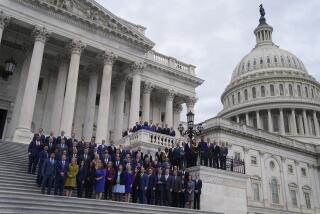Heading Onward and Upward in Nation’s Capitol
I clutched the narrow railing inside the Capitol dome and stared over my shoulder at Sen. Pete Wilson. He had seemed charming at ground level, but this was 58 feet above the marble rotunda floor.
Who needs friends in high places?
As it turns out, we all do.
Back in the days of softer security, anyone could make this trek and savor a sweeping view of Washington, D.C., and its monuments.
Sketches from the 1870s show tourists climbing the lower stairs in top hats and long frocks with bustles. But many people fainted and had to be carried down, especially in the stifling heat of summer. The area was finally closed to the public.
Today you cannot make the climb unless accompanied by a member of Congress, not all of whom are able or willing.
Wilson, whom I’ve known since his days as mayor of San Diego, is a good sport. To his credit he tried to dissuade me. But my curiosity won out.
After a salad in the Senate dining room we met a nimble lad named Joe from the Capitol architect’s office. Joe unlocked a small door and led us into a shadowy passageway with a single chair. I changed from leather flats to tennis shoes.
The first part of the climb was a tight spiral staircase. Then we stepped out onto a grid that reached like a fire escape between the old dome frame and the new.
The original dome was low and squat, a wooden structure covered with copper. The tiered, cast-iron dome of today began rising during the Civil War.
When advisers suggested that construction be halted and funds preserved for pressing matters, former President Abraham Lincoln said: “If the people see the Capitol going on, it is a sign that we intend the Union shall go on.”
The dome rises 180 feet above the floor of the rotunda, the hundred-foot-wide circular hall where Presidents from Lincoln to John F. Kennedy have lain in state, the place where Capitol visitors meet tour guides.
At the first landing, more than six stories up, Joe leaned into the void to describe a mammoth frieze, begun by an Italian artist named Constantino Brumidi, who fell from a scaffolding and died. Voices wafted from below. I found that I could not look.
“It’s odd,” Wilson said, “but the first time I climbed the dome I was amazed that the view from the top bothered me a lot less than from right here. It must have something to do with the dome being narrower up there. This level is so broad; it still makes me a little dizzy.”
I hate mind readers.
Within minutes the senator looked at his watch. “It’s later than I thought,” he said. “I have an appointment. Enjoy your trip.”
With a wave he was gone. Joe smiled at me and said: “Ready?” My smile was as weak as my knees. Only my resolve stood firm.
Now the stair was like a jungle-gym ladder of curved rungs and crawl spaces. We were between sloping walls of peeling paint.
“This is the only rosette in the ceiling that opens,” Joe said, lifting a section like a porthole. “That’s how they get to the wiring.”
I wondered what someone below might think if they glanced up and saw the sudden gap.
Near the crown of the ceiling we emerged onto a narrow walkway 20 stories above the rotunda floor. Joe scurried to the other side to demonstrate the echo. He described an ethereal scene of George Washington with 13 nymphs, representing the 13 original colonies.
He said that the fresco includes gods and mortals: the wise Minerva talking to Benjamin Franklin, Mercury offering gold to Robert Morris, financier of the Revolution. He added that the ceiling was restored just last year, which is why it seems bright as new.
I glanced up, but had to take Joe’s word for details. I was ready for fresh air.
“How many steps are there in the dome?” I asked in a voice that cracked.
“Three hundred sixty-five,” Joe said. “One for each day in the year.”
At the next door we pushed outside; the graceful spokes of Washington’s streets splayed in all directions. I eased around the windy dome, hugging the wall as I moved.
There was Arlington National Cemetery; the monuments to Washington, Lincoln and Jefferson; there were the Smithsonian museums, the White House and the rippled roof of RFK Stadium.
Overhead was the Statue of Freedom, a 20-foot-tall bronze with stars on her forehead and a headdress of eagle feathers. She has been atop the Capitol dome since 1863.
Joe said that rain, lightning and 125 years have taken their toll on Freedom, and the statue will soon be removed for restoration.
The plan is to take the lady down by helicopter, a notion that I admit fluttered through my mind during some twists of those back stairs.
More to Read
Sign up for The Wild
We’ll help you find the best places to hike, bike and run, as well as the perfect silent spots for meditation and yoga.
You may occasionally receive promotional content from the Los Angeles Times.






